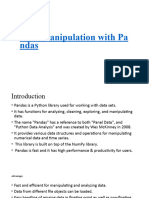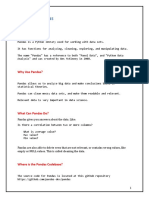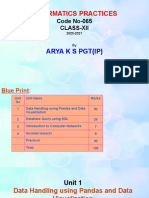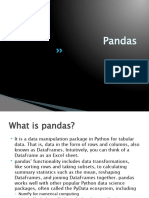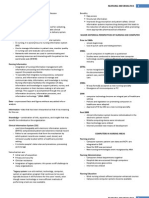101 - Introducing DataFrames - Python
Uploaded by
Радомир Мутабџија101 - Introducing DataFrames - Python
Uploaded by
Радомир Мутабџија12/05/2021 Introducing DataFrames | Python
1. Introducing DataFrames
Hi, I'm Richie. I'll be your tour guide through the world of pandas.
2. What's the point of pandas?
pandas is a Python package for data manipulation. It can also be used for data visualization; we'll
get to that in Chapter 4.
3. Course outline
We'll start by talking about DataFrames, which form the core of pandas. In chapter 2, we'll discuss
aggregating data to gather insights. In chapter 3, you'll learn all about slicing and indexing to
subset DataFrames. Finally, you'll visualize your data, deal with missing data, and read data into a
DataFrame. Let's dive in.
4. pandas is built on NumPy and Matplotlib
pandas is built on top of two essential Python packages, NumPy and Matplotlib. Numpy provides
multidimensional array objects for easy data manipulation that pandas uses to store data, and
Matplotlib has powerful data visualization capabilities that pandas takes advantage of.
5. pandas is popular
pandas has millions of users, with PyPi recording about 14 million downloads in December 2019.
This represents almost the entire Python data science community!
1
https://pypistats.org/packages/pandas
6. Rectangular data
There are several ways to store data for analysis, but rectangular data, sometimes called "tabular
data" is the most common form. In this example, with dogs, each observation, or each dog, is a
row, and each variable, or each dog property, is a column. pandas is designed to work with
rectangular data like this.
7. pandas DataFrames
In pandas, rectangular data is represented as a DataFrame object. Every programming language
used for data analysis has something similar to this. R also has DataFrames, while SQL has
database tables. Every value within a column has the same data type, either text or numeric, but
different columns can contain different data types.
8. Exploring a DataFrame: .head()
When you first receive a new dataset, you want to quickly explore it and get a sense of its contents.
pandas has several methods for this. The first is head, which returns the first few rows of the
DataFrame. We only had seven rows to begin with, so it's not super exciting, but this becomes very
useful if you have many rows.
9. Exploring a DataFrame: .info()
The info method displays the names of columns, the data types they contain, and whether they
have any missing values.
10. Exploring a DataFrame: .shape
A DataFrame's shape attribute contains a tuple that holds the number of rows followed by the
number of columns. Since this is an attribute instead of a method, you write it without parentheses.
11. Exploring a DataFrame: .describe()
https://campus.datacamp.com/courses/data-manipulation-with-pandas/transforming-data?ex=1 1/2
12/05/2021 Introducing DataFrames | Python
The describe method computes some summary statistics for numerical columns, like mean and
median. "count" is the number of non-missing values in each column. describe is good for a quick
overview of numeric variables, but if you want more control, you'll see how to perform more specific
calculations later in the course.
12. Components of a DataFrame: .values
DataFrames consist of three different components, accessible using attributes. The values
attribute, as you might expect, contains the data values in a 2-dimensional NumPy array.
13. Components of a DataFrame: .columns and .index
The other two components of a DataFrame are labels for columns and rows. The columns attribute
contains column names, and the index attribute contains row numbers or row names. Be careful,
since row labels are stored in dot-index, not in dot-rows. Notice that these are Index objects, which
we'll cover in Chapter 3. This allows for flexibility in labels. For example, the dogs data uses row
numbers, but row names are also possible.
14. pandas Philosophy
Python has a semi-official philosophy on how to write good code called The Zen of Python. One
suggestion is that given a programming problem, there should only be one obvious solution. As
you go through this course, bear in mind that pandas deliberately doesn't follow this philosophy.
Instead, there are often multiple ways to solve a problem, leaving you to choose the best. In this
respect, pandas is like a Swiss Army Knife, giving you a variety of tools, making it incredibly
powerful, but more difficult to learn. In this course, we aim for a more streamlined approach to
pandas, only covering the most important ways of doing things.
1 https://www.python.org/dev/peps/pep-0020/
15. Let's practice!
Enough meditating, time to write some code!
https://campus.datacamp.com/courses/data-manipulation-with-pandas/transforming-data?ex=1 2/2
You might also like
- 000 - Data Manipulation With Pandas - DataCamp100% (1)000 - Data Manipulation With Pandas - DataCamp5 pages
- Exp1 - Manipulating Datasets Using PandasNo ratings yetExp1 - Manipulating Datasets Using Pandas15 pages
- Introduction To Pandas For Data AnalysisNo ratings yetIntroduction To Pandas For Data Analysis6 pages
- Practical Guide To Pandas For Data ScienceNo ratings yetPractical Guide To Pandas For Data Science26 pages
- Python Pandas Module - Introduction-07-11-2023No ratings yetPython Pandas Module - Introduction-07-11-202384 pages
- Introduction To Pandas in Data AnalyticsNo ratings yetIntroduction To Pandas in Data Analytics12 pages
- RA Continuing Education (Data Processing With Pandas)No ratings yetRA Continuing Education (Data Processing With Pandas)77 pages
- Learning the Pandas Library Python Tools for Data Munging Analysis and Visual Matt Harrison - The full ebook version is available, download now to explore100% (1)Learning the Pandas Library Python Tools for Data Munging Analysis and Visual Matt Harrison - The full ebook version is available, download now to explore62 pages
- Python Pandas Tutorial_ the Ultimate Guide for BeginnerNo ratings yetPython Pandas Tutorial_ the Ultimate Guide for Beginner32 pages
- Learn Python Pandas For Data Science Quick TutorialExamples For All Primary Operations of DataFramesNo ratings yetLearn Python Pandas For Data Science Quick TutorialExamples For All Primary Operations of DataFrames37 pages
- 06 MGMT 590 Fall 2019 Data Handling With Pandas(1)No ratings yet06 MGMT 590 Fall 2019 Data Handling With Pandas(1)14 pages
- 20 Pandas Functions For 80% of Your Data ScienceNo ratings yet20 Pandas Functions For 80% of Your Data Science22 pages
- 3Y3Z2Xzqn7 U Y%K : 2. How To Create A Data Frame Using A Dictionary of Pre-Existing Columns or Numpy 2D Arrays?No ratings yet3Y3Z2Xzqn7 U Y%K : 2. How To Create A Data Frame Using A Dictionary of Pre-Existing Columns or Numpy 2D Arrays?8 pages
- 13 Boost Your Data Analysis With PandasNo ratings yet13 Boost Your Data Analysis With Pandas21 pages
- 1stmarch Updated Version - February, New Topics, Presentation Online Course 2021No ratings yet1stmarch Updated Version - February, New Topics, Presentation Online Course 202127 pages
- Master of European Legal Studies - MELS Online: Faculty AlumniNo ratings yetMaster of European Legal Studies - MELS Online: Faculty Alumni2 pages
- Tipkamo Li U Mraku?-Upalimo Svjetlo!: Annex 1No ratings yetTipkamo Li U Mraku?-Upalimo Svjetlo!: Annex 12 pages
- Resources To Learn Statistical Programs: SPSS Webpage: Ucla: SPSS Tutorial: SPSS ListNo ratings yetResources To Learn Statistical Programs: SPSS Webpage: Ucla: SPSS Tutorial: SPSS List1 page
- Sampling Methods: 1 Simple Random Sampling (S.R.S.)No ratings yetSampling Methods: 1 Simple Random Sampling (S.R.S.)1 page
- What Is AAA_ Authentication, Authorization, and Accounting _No ratings yetWhat Is AAA_ Authentication, Authorization, and Accounting _4 pages
- 5 - Marris TLS 31 TOCPA Finland 9 Mar 2017 Rev100% (2)5 - Marris TLS 31 TOCPA Finland 9 Mar 2017 Rev34 pages
- Virtualization: Virtualization and Basics of VirtualizationNo ratings yetVirtualization: Virtualization and Basics of Virtualization16 pages
- Com 214 File Organization and Management Practical100% (1)Com 214 File Organization and Management Practical48 pages
- Fortinet Recertified ISO 9001:2011 Certification For High Standards of Quality ManagementNo ratings yetFortinet Recertified ISO 9001:2011 Certification For High Standards of Quality Management2 pages
- A Python Book - Beginning Python, Advanced Python, and Python Exercises PDFNo ratings yetA Python Book - Beginning Python, Advanced Python, and Python Exercises PDF246 pages
- Ii: Marathi:: Name & Signature of Invigilator/sNo ratings yetIi: Marathi:: Name & Signature of Invigilator/s8 pages
- I Passed RHCSA 8, WOOO! Also Some Tips For Your Exam RedhatNo ratings yetI Passed RHCSA 8, WOOO! Also Some Tips For Your Exam Redhat9 pages
- CSI247: Lab 1 - More Objects and Inheritance: Figure 1: UML Diagram of The Class HierarchyNo ratings yetCSI247: Lab 1 - More Objects and Inheritance: Figure 1: UML Diagram of The Class Hierarchy2 pages

















